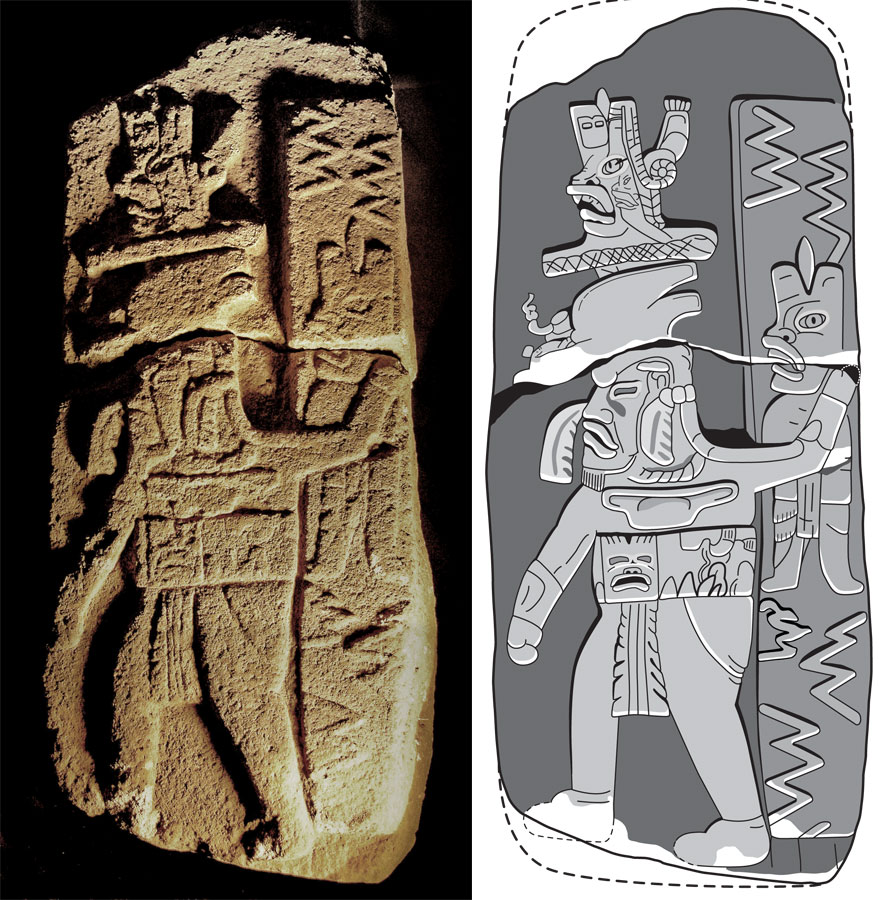The main character in the sculpted relief of a newly discovered stone monument has one arm raised and a determined scowl, but John Hodgson, a University of Wisconsin-Madison archaeologist feels that we may never know who he was or indeed, the true meaning of the sculpture in its entirety.
The stone monument was discovered in 2009 at a site called Ojo de Agua in the southern state of Chiapas, Mexico, and is described in the cover article of the current issue (December 2010) of Mexicon.
Monument 3 is the second sculpted relief to be found in Ojo de Agua. Monument 1 was discovered by accident when a local farmer hit it with a plough in the 1960s and Monument 3 was a similarly fortuitous find, uncovered in the process of digging an irrigation ditch. (Monument 2 is a large boulder with a flat surface but with no visible carving, found by Hodgson in 2005).
Hodgson was fortunate to be working in the area and was told of the find just a few days after its discovery. Rushing to the site he was still able to see the impression of the carving in the sides of the trench and he could record the layers where it had been buried, gaining a wealth of information that is usually lost in chance discoveries such as this.
"Usually sculptures are first seen by archaeologists in private art collections and we normally have no good idea where they came from. The depictions of figures and the motifs change in form through time so you can get an approximate date by comparing styles," he said. "But we were able to date the new monument by where it was found to a narrow 100-year window, which is very rare."Examination of the archaeological context, comparative analysis of ceramic sherds associated with the stone monument and radiocarbon dating, gave a date of 1100 to 1000 BCE, making it approximately 3,000 years old. Its age and style correspond to the Early Formative period, when an early culture known as the Olmec dominated the area.
Its purpose and meaning, however, will be harder to ascertain.
The main figure on the tablet is depicted wearing an elaborate headdress, loincloth and ornate accessories, including a pair of large, comb-like ear ornaments, a rope-like necklace and a thick belt with a jaguar-head buckle. A face on the headdress includes features such as sprouting plants that identify it as a corn god. The tablet also includes a smaller secondary figure and a series of asymmetric zigzag designs that suggest lightning, local mountain ranges, or other features of the natural world. Zigzags are closely connected with agriculture and the cult of the corn god, representing the thunderstorms that bring the rain.

The depiction of corn is particularly notable, associating the site with a settled farming community and confirming the complexity of the society that once inhabited the area as well as showing an early association between corn and religion.
Ojo de Agua is the earliest known site in Mesoamerica with formal pyramids built around plazas and though it has not been examined extensively as an archaeological site, initial reports are that it covers about 200 hectares making it the largest site in the area from the time period 1200-1000 BCE. The limited work to date describes civic architecture consistent with a moderately sized planned settlement. The identified platform mounds are laid out in a deliberate alignment that may be relative to magnetic north.
Hodgson expects there are many more clues at Ojo de Agua and hopes to have the opportunity to continue working at the site.




Reader Comments
to our Newsletter